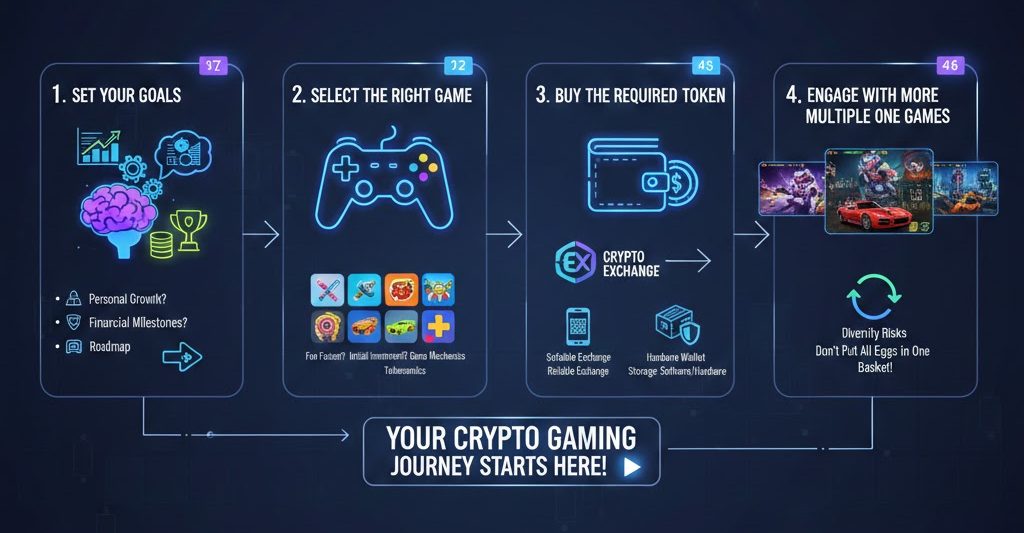Earning Tradeable Assets While Playing? Here’s How Crypto Gaming Makes It Possible

Immersing yourself in a thrilling experience is one thing, but doing so while reaping tangible rewards is a whole other story that’s changing how gamers think about play and profit. Suppose you’ve been into digital gaming for a while now. In that case, it’s impossible not to have heard about crypto gaming, which is, to put simply, a blend of traditional gaming experiences with the innovative crypto realm. Is it a one-in-a-lifetime opportunity? Yes. Is it a landscape rife with risks? Also yes.
If you keep an eye on the crypto news today, it’s enough to see that the value of digital tokens can fluctuate rapidly, which means it’s easy to lose your money if you sell tokens at the wrong time. Besides, crypto is still a nascent industry and is subject to regulatory uncertainty, adding further risk. But with proper research and adequate tools, it can be not only entertaining but also profitable, so if the risks don’t bother you much, it’s definitely worth getting started with crypto gaming. But first, you should understand its ins and outs, so read on to learn more.
What Exactly Is Crypto Gaming and How Does It Work?
Most gamers are familiar with conventional virtual currencies like gems, gold, and coins, which hold value only within a game’s ecosystem. But crypto gaming is revolutionary because it introduces currencies that actually have real-world value, not just within the game, allowing players to trade, earn, and cash out their in-game assets – and it’s all thanks to the blockchain. Crypto games feature established cryptocurrencies like Ethereum and Bitcoin, and they also incorporate NFTs, which are unique digital assets that hold specific details and attributes and cannot be exchanged one-to-one.
Crypto gaming is transforming the modern gaming landscape as it was known: for game creators, it is a groundbreaking way to motivate gameplay and foster a deeper connection with players. Beyond this, it democratises the gaming economy by giving players actual ownership of their in-game assets, a stark departure from conventional models in which assets remain under the control of platforms and game developers.
At its core, crypto gaming relies on gameplay elements that have been tested time and time again — battles, quests, exploration, etc., with the primary distinction being the reward structure. These rewards transcend the gaming ecosystem, which is precisely what makes them so appealing: rather than being mere points on a scoreboard, they are assets with real-world value that players can trade on crypto exchanges, list on NFT marketplaces, or convert to traditional money.
What Are Some of the Most Popular Crypto Games Out There?
You know what crypto gaming is and how it works, but you may also want to know a little bit about the most famous crypto games. After all, it’s these games that show the true potential of this niche. One of the crypto games that’s become a real hit is Axie Infinity, which draws inspiration from the beloved Pokémon series. In the game, players can collect, breed, and raise Axies, which are endearing monster NFTs, and then use them in a battle with other players or trade them. This game takes a Play-to-Earn approach, enabling players to earn AXS tokens, but it’s notably not just a simple game: it’s a movement that’s spawning academies and scholarship programs.
Another game that has gained massive popularity is Sandbox, often compared to Roblox or Minecraft. The game allows players to build their own worlds, create structures, interact with others, and shape unique experiences in a decentralised world. Compared to traditional games, players can make a whole experience to monetise, not just in-game items. Then there’s also Gods Unchained, which stands out from other crypto titles through its free-to-play model. What does this mean? You can jump in without spending a dime and still have the chance of earning income as you play, quite an exciting endeavour.
What Are the Steps to Getting Started with Crypto Gaming?

Since you can earn real money by playing crypto games, you’re probably curious about how actually to get started with it. After all, who wouldn’t be excited to participate in this emerging trend? Here are the steps you need to take if you want to dive into this world:
- Set Your Goals. First things first, what are you hoping to achieve by starting your crypto gaming adventure? Is it personal growth? Financial milestones? Think it through carefully, and once you do, begin strategising. In other words, create a roadmap that mentions the methods that will allow you to meet your goals, from the choices of games to risk management.
- Select The Right Game. What’s the point of embarking on your crypto gaming journey if you aren’t having any fun? Joy is an essential factor to keep in mind when making a decision, because after all, the game shouldn’t feel like a chore! Also, check whether it requires an initial investment, and if so, ask yourself whether you can afford it. Look into the game’s mechanics and the revenue model of the developers to see if you’re familiar with them, and look into the in-game token’s economic structure as well.
- Buy The Required Token ( If That’s The Case). Not all crypto games are free; in some instances, it may be necessary to own a specific crypto so you can get started. To buy the asset, it’s imperative to choose a reliable crypto exchange platform. Once you’ve done that, the next step is to consider storage. For Play-to-Earn games, a software crypto wallet is indispensable, facilitating NFT purchases and connecting you to the best games. But at the same time, you should also consider a hardware wallet, which enhances security by storing your keys offline.
- Engage With More Than One Game. Since crypto is volatile, diversification is essential to reduce risks. Suppose one game stops bringing you fun and profits; you can always choose another game instead, so it’s always better than putting all your eggs into one basket.
Bottom Line
The entry of blockchain into the gaming sector signals a new era. In this world, players can own and earn from their in-game items for real, but notably, it isn’t about excitement alone: by understanding the game mechanics and market trends, they can also make passive income. Crypto investing knowledge, especially about diversification, is essential for maximising rewards and mitigating risks. So, will you start your crypto gaming adventure and find out what it really means to play for fun and profit at the same time?
Disclaimer
- The information provided in this article is for educational and informational purposes only and should not be interpreted as financial, investment, or legal advice.
- Cryptocurrency markets are highly volatile, and participation in crypto gaming, blockchain-based platforms, or digital asset trading carries significant risk, including potential loss of capital.
- Readers should conduct their own research and, where appropriate, consult with a qualified financial or legal professional before making any decisions involving digital assets.
- The mention of specific games, platforms, or tokens does not constitute endorsement or recommendation.
References
- Sky Mavis. Axie Infinity Whitepaper v1.3. 2018.
- The Sandbox Team. The Sandbox Metaverse Documentation. 2020–2024.
- Immutable. Gods Unchained Whitepaper. 2021.
- Narayanan, Arvind, et al. Bitcoin and Cryptocurrency Technologies: A Comprehensive Introduction. Princeton University Press, 2016.
- European Securities and Markets Authority (ESMA). Crypto-Asset Market Risks Report. 2023.
- Chainalysis Research Team. The State of Web3 & Play-to-Earn Gaming. 2022.
- DappRadar Analytics. Blockchain Gaming Industry Overview. 2023.
- Messari Research. Crypto Market Volatility & Sector Risk Analysis. 2023.
- Delphi Digital. Play-to-Earn Gaming Ecosystem Report. 2022.
